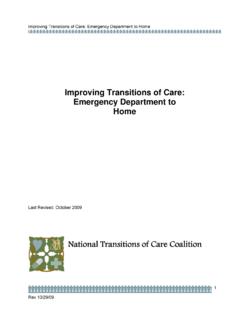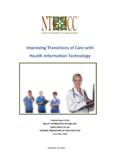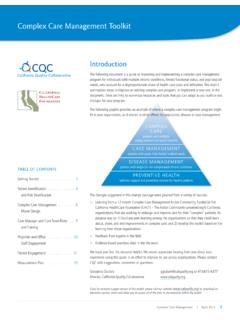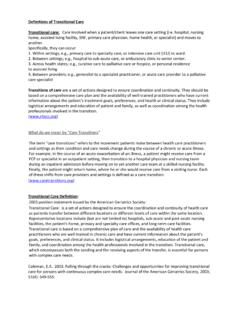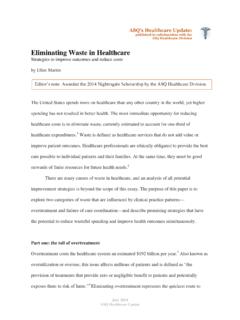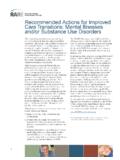Transcription of ED Transfer Communication Toolkit for Web - …
1 Toolkit for emergency Department Transfers Stratis Health _____ 0 Quality Improvement Toolkit for emergency Department Transfer Communication Measures _____ Stratis Health, based in Bloomington, Minnesota, is a nonprofit organization that leads collaboration and innovation in health care quality and safety, and serves as a trusted expert in facilitating improvement for people and communities. This material was prepared by Stratis Health, the Minnesota Medicare Quality Improvement Organization, under a contract with the Centers for Medicare & Medicaid Services (CMS), an agency of the Department of Health and Human Services. The contents presented do not necessarily reflect CMS policy. 10 SOW-MN-SIP TRUE EDT-14-16 022514 Toolkit for emergency Department Transfers Stratis Health _____ 1 Table of Contents Section 1: Recommendations and Principles of care Transitions from the emergency Department.
2 2 care Transitions and the emergency Department: Overview .. 2 American College of emergency Physicians care Transition Task Force Recomendations: .. 3 Safe Transfers and Hand-offs: emergency Department Principles .. 3 Section 2: Developing and Implementing an Action Plan .. 5 Quality Improvement Basics .. 5 Establishing an ED Transfer Improvement Team .. 7 Developing an Action Plan .. 9 Implementing your Action Plan: Education and Training .. 11 Section 3: Sample Checklists, Logs, and Transfer Forms .. 12 Sample Checklist .. 12 Sample Transfer Forms .. 12 Additional Resources .. 14 The electronic version of this document contains clickable links to online tools and resources, and is available for download on the Stratis Health website at: Toolkit for emergency Department Transfers Stratis Health _____ 2 Section 1: Recommendations and Principles of care Transitions from the emergency Department The importance of Communication has been recognized as a key factor in safe and efficient patient transfers and several leading organizations have highlighted recommendations and principles specific to emergency department situations.
3 care Transitions and the emergency Department: Overview As health care has become more specialized, with greater numbers of clinicians in different care settings involved in patient care , patients are likely to encounter more handoffs than in years past. Clinical environments are dynamic and complex, presenting many challenges for effective Communication among health care providers, patients, and families. Transfers from the emergency department often result in a series of handoffs between emergency medical services (ground and/or air transport) other hospital emergency departments and a receiving facility. Many of the health care providers and staff engaged in these transfers are unfamiliar with the settings and the care delivery details where they are sending patients and may not provide adequate Communication to support effective care .
4 Ineffective and inefficient transitions can lead to poor outcomes such as: delays in diagnosis, medication errors, adverse events, inappropriate or unnecessary treatments, patient complaints, increased lengths of stay, and/or increased costs. The conceptual model for Transitions of care (Figure 1 below) was developed by the National Transitions of care Coalition to help provide context for the importance of accurate and timely Transfer of information from emergency room providers and the next setting of care . The single biggest problem with communications is the illusion that it has taken place. - George Bernard Shaw Toolkit for emergency Department Transfers Stratis Health _____ 3 American College of emergency Physicians care Transition Task Force Recomendations: To better support effective transfers from the emergency department the American College of emergency Physicians outlined several recommendations in a 2012 report on improving care coordination.
5 The following recommendations are relevant to the emergency Department Transfer Communication Measure Set: Enhance and promote training and education for all emergency department personnel regarding the importance of transitions of care and how to implement effective policies and procedures. Assess provider performance, with appropriate feedback, and provide training in Communication skills as necessary. Work with emergency department information system vendors to produce transition support tools and identify the components of a minimum data set for all transitions. Full Report: ACEP Transitions of care Task Force Report, 2012 Safe Transfers and Hand-offs: emergency Department Principles The American College of emergency Physicians (ACEP), emergency Nurses Association (ENA), National Association of EMS Physicians (NAEMSP), National Association of emergency Medical Technicians (NAEMT), and National Association of State EMS Officials (NASEMSO) have developed a series of principles to ensure safe transfers and hand-offs from hospital to hospital and from EMS to the hospital.
6 When thinking about making improvement to your emergency department Transfer processes, consider these principles: Principles for Interhospital Transfers1 The optimal health and well-being of the patient should be the principal goal of patient Transfer . emergency physicians and hospital personnel should abide by applicable laws regarding patient Transfer . All patients should be provided a medical screening examination (MSE) and stabilizing treatment within the capacity of the facility before Transfer . If a competent patient requests Transfer before the completion of the MSE and stabilizing treatment, these should be offered to the patient and documented. Hospital policies and procedures should articulate these obligations and ensure safe and efficient Transfer . The transferring physician should inform the patient or responsible party of the risks and the benefits of Transfer and document these.
7 Before Transfer , patient consent should be obtained and documented whenever possible. The hospital policies and procedures and/or medical staff bylaws should identify the individuals responsible for and qualified to perform MSEs. The policies and procedures or bylaws must define who is responsible for accepting and transferring patients on 1 Appropriate Interhospital Patient Transfer , ACEP, retrieved January 11, 2014, Toolkit for emergency Department Transfers Stratis Health _____ 4 behalf of the hospital. The examining physician at the transferring hospital will use his or her best judgment regarding the condition of the patient when determining the timing of Transfer , mode of transportation, level of care provided during Transfer , and the destination of the patient.
8 Transfers are effected through qualified personnel and transportation equipment, as required, including the use of necessary and medically appropriate life support measures during the Transfer . Agreement to accept the patient in Transfer should be obtained from a physician or responsible individual at the receiving hospital in advance of Transfer . When a patient requires a higher level of care other than that provided or available at the transferring facility, a hospital with the capability and capacity to provide a higher level of care may not refuse any request for Transfer . An appropriate medical summary and other pertinent records should accompany the patient to the receiving facility or be electronically transferred as soon as is practical. When Transfer of patients is part of a regional plan to provide optimal care at a specialized medical facility, written Transfer protocols and interfacility agreements should be in place.
9 Notes: To ensure optimal patient care , nonhospital satellite medical facilities should abide by Transfer standards much the same as those outlined above. Laws and regulations relevant to the emergency Medical Treatment and Labor Act1 (EMTALA) exist in many states. Physicians who participate in patient Transfer decisions should be aware of applicable state-specific Transfer laws and regulations. 1 The emergency Medical Treatment and Active Labor Act, as established under the Consolidated Omnibus Budget Reconciliation Act (COBRA) of 1985 (42 USC 1395 dd) and 42 CFR ; 42 CFR (EMTALA regulations). Principles for Hand-offs Between EMS and Receiving Facilities2 In addition to a verbal report from EMS providers, minimum key information required for patient care must be provided in written or electronic form at the time of Transfer of patient care .
10 This ensures that physicians and other health care providers who deliver subsequent care for the patient receive more accurate information and avoid potential errors inherent with second-hand information. The minimum key information reported at the time of hand-off must include information that is required for optimal care of the patient examples include vital signs, treatment interventions, and the time of symptom onset for time-sensitive illnesses. All members of the health care team, including EMS providers, nurses, and physicians, must communicate with mutual respect for each other and respect the verbal and written Communication from EMS as an important part of the patient s history. During the Transfer of patient care , the receiving health care providers should have an opportunity to ask questions to clarify information that is exchanged.







